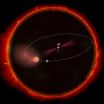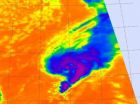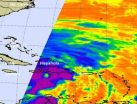(Press-News.org) This press release is available in German.
Pulsars are the compact remnants from explosions of massive stars. Some of them spin around their own axis hundreds of times per second, emitting beams of radiation into space. Until now, they could only be found through their pulsed radio emissions. Now, scientists at the Max Planck Institute for Gravitational Physics (Albert Einstein Institute/AEI) in Hanover assisted by the Max Planck Institute for Radio Astronomy have discovered a millisecond pulsar solely via its pulsed gamma radiation. A new data analysis method developed by the AEI was crucial for the success. The pulsar is accompanied by an unusual sub-stellar partner, which it is vaporizing, hence the name "black widow".
Back in 1994, astronomers discovered a source of strong gamma-rays in the constel-lation of Centaurus. They suspected that a pulsar was the origin of the energetic radiation. Now, a team of scientists led by Holger Pletsch from the Max Planck Institute for Gravitational Physics (Albert Einstein Institute, AEI) has solved the mystery and identified the culprit: the millisecond gamma-ray pulsar PSR J1311-3430. The developement of a new data analysis method by the AEI scientists enabled the discovery, since rapidly spinning pulsars are extremely difficult to find.
To unambiguously identify a gamma-ray pulsar, astronomers must know its properties to very high precision. This includes its position, spin frequency, and how the latter changes over time. If the pulsar is in a binary system, the analysis problem is even more complicated: at least three additional orbital parameters have to be determined as well.
In the case of PSR J1311-3430 astronomers had already observed the companion, which is heated by the radiation from the pulsar, with optical telescopes. They were thus able to partially constrain the orbital parameters and confine the position of the pulsar.
"We developed a particularly efficient method to search the data from NASA's Fermi satellite for gamma-ray millisecond pulsars, including those in binary systems. Only this method enabled us to probe the wide parameter ranges," says Holger Pletsch, lead author of the article published in Science. The new analysis method enables scientists to conduct a 'blind search' for gamma-ray millisecond pulsars for the first time – right up to very high spinning frequencies.
The scientists analysed the Fermi data on the Atlas computer cluster at the AEI. "Our search used data collected by the gamma-ray satellite over a total of four years. Very soon after we started running the analysis, a clear signal showed up in the results. What we saw was very exciting," says Pletsch.
PSR J1311-3430 spins 390 times per second, emitting gamma-ray photons into space in the form of a beam, similar to a lighthouse. In roughly one in a million revo-lutions of the pulsar, a single photon reaches the detector on board Fermi.
The gamma-ray signal also reveals much about the companion to the astronomers: the orbital motion of the binary system modulates the photon arrival times, yielding information about the partner star. "The companion object is small and unusually dense," says AEI Director Bruce Allen. "It is at least eight times as massive as the planet Jupiter, but has at most 60 percent the planet's radius."
From this information, the researchers calculated the density of the companion, which turned out to be unusually high; it is around 30 times as dense as the Sun. Presumably, the small companion is the compact remnant of a star which has been orbiting the pulsar since earlier times. Over time, the pulsar accreted matter from the star, thereby accelerating its rotation. Pulsar and companion moved closer and closer together.
"At present, the remaining stellar core, which presumably consists mainly of helium, is heated by the radiation from the pulsar and literally evaporated," says Holger Pletsch. Astronomers call this type of pulsar a 'black widow', in analogy with a spe-cies of spider which kills the smaller male after mating. In the distant future, PSR J1311-4330 might possibly completely vaporize its companion and from then on trav-el through space alone.
And that's not all: "Our discovery is not only a first, it also sets several new records," explains Bruce Allen. Currently, the odd couple is orbiting its common centre of mass on an almost perfect circular trajectory in only 93 minutes. This is the shortest known orbital period of all pulsars in binary systems.
At a distance of only 1.4 Earth-Moon separations, the binary system is the closest one known to date with a pulsar. The pulsar is speeding along its circular orbit with at least 13,000 kilometres per hour. Its light-weight companion is even faster, at up to 2.8 million kilometres per hour.
Holger Pletsch and his colleagues also had a close look at older observations with the Green Bank radio telescope in West Virginia, but were unable to find the fast pulsar here. "Apparently, the cloud of vaporized material from the companion absorbs most of the radio wave emissions from the pulsar and possibly makes it invisible to radio telescopes," says Lucas Guillemot from the Max Planck Institute for Radio Astronomy in Bonn, co-author of the publication. The scientists are already planning further observations at higher radio frequencies. They hope to use them to accurately determine the object's distance from Earth, for example.
Systems like this provide astronomers with new insights into the evolution of very close binary systems, which are as yet still incompletely understood. PSR J1311-3430 could also shed new light on the generation of the gamma-ray photons and radio emissions in the strong magnetic field of pulsars. The pulsar may just be the tip of the iceberg: many other unidentified gamma-ray sources may harbour similarly unusual systems. Thirty years after the discovery of the first millisecond pulsar in the radio range, the novel analysis method of the Max Planck researchers at the AEI has opened a new door to the easier identification of these elusive celestial objects.
INFORMATION:
Pletsch, H.J. et al.,
Binary Millisecond Pulsar Discovery via Gamma-Ray Pulsations
Science Express, 25 October 2012
A black widow's Tango Mortale in gamma-ray light
Max Planck scientists discover record-breaking millisecond pulsar with new analysis method
2012-10-26
ELSE PRESS RELEASES FROM THIS DATE:
Smoking takes 10 years off life expectancy in Japan, not 4 as previously thought, experts warn
2012-10-26
Smoking reduces life expectancy by ten years in Japan, but much of the risk can be avoided by giving up smoking, a paper published on bmj.com today shows.
Previous studies in Japan suggested smoking reduced life expectancy by only a few years compared with about ten years in Britain and the USA. This new report, from researchers in Oxford and Japan, investigates the impact of smoking on mortality in a large group of Japanese people who were living in Hiroshima or Nagasaki in 1950. The findings are, however, nothing to do with radiation exposure from the bombs.
The ...
US investment in biomedical and health research on downward trend
2012-10-26
WASHINGTON, DC—October 25, 2012—Biomedical and health research and development (R&D) spending from all sources declined by more than $4 billion or 3% between FY10 and FY11 according to Research!America's 2011 U.S. Investment in Health Research report. This represents the first drop in overall spending since Research!America began compiling the data in 2002.
The decline follows an uptick in research funding attributed to the American Recovery and Reinvestment Act (ARRA), which allocated $10.4 billion to the National Institutes of Health (NIH) over two fiscal years (2009-2010). ...
NASA sees warming cloud tops indicating Tropical Storm Tony weakening
2012-10-26
In a tropical cyclone, strong uplift of air pushes the tops of thunderstorms high into the troposphere. When that strength wanes, the cloud tops drop and become less cold. That's because the higher you go in the troposphere, the colder it gets. NASA satellite infrared data has revealed that Tropical Storm Tony's cloud top temperatures are warming and the storm is weakening.
The Atmospheric Infrared Sounder (AIRS) instrument aboard NASA's Aqua satellite captured infrared imagery of Tropical Storm Tony on Oct. 24 at 12:17 p.m. EDT that showed the strongest thunderstorms ...
NASA sees power in Hurricane Sandy moving toward Bahamas
2012-10-26
NASA's Aqua satellite passed over Hurricane Sandy as it was moving over eastern Cuba early on Oct. 25. The AIRS instrument captured an infrared image of Sandy that showed a large area of very high, cold cloud tops indicating the power within the storm. Sandy is now headed toward the Bahamas and warnings and watches have already been posted for the mainland U.S.
The Atmospheric Infrared Sounder (AIRS) instrument aboard NASA's Aqua satellite captured infrared imagery of Hurricane Sandy's eastern half on Oct. 25 at 0559 UTC (1:59 a.m. EDT) that showed some strong thunderstorms ...
NASA saw Tropical Storm Murjan making landfall on the Horn of Africa
2012-10-26
NASA's Aqua satellite watched from space as Somalia in the Horn of Africa experienced a landfalling tropical cyclone on Oct. 25.
On Oct. 25, NASA's Aqua satellite saw Tropical Storm Murjan begin to make landfall in eastern Somalia, just south of Cape Guardafui. Cape Guardafui is located in the northeastern Bari province and forms the geographical point of the Horn of Africa.
On Oct. 25, 2012 at 0720 UTC (3:20 a.m. EDT) the Moderate Resolution Imaging Spectroradiometer (MODIS) instrument that flies aboard NASA's Aqua satellite captured a visible image of Tropical Storm ...
USF researchers identify gene mutation linked to old age hearing loss
2012-10-26
TAMPA, Fla. (Oct. 25, 2012) - University of South Florida researchers have identified a genetic biomarker for age-related hearing loss, a major breakthrough in understanding and preventing a condition of aging that affects 30 million Americans and greatly diminishes their quality of life.
In a nine-year study that was a collaboration between USF's Global Center for Hearing & Speech Research and the National Technical Institute for the Deaf at the Rochester Institute of Technology, researchers were able to identify the first genetic biomarker for presbycusis. The genetic ...
NASA sees Tropical Storm Son-tinh moving into South China Sea
2012-10-26
Tropical Storm Son-tinh soaked the Philippines and is now moving into the South China Sea. NASA's Aqua satellite captured a visible image of the storm as the bulk western half of the storm had already moved over water.
On Oct. 25, 2012 at 0525 UTC (1:25 a.m. EDT) the Moderate Resolution Imaging Spectroradiometer (MODIS) instrument that flies aboard NASA's Aqua satellite captured a visible image of Tropical Storm Sin-Tingh. The image showed that the western half of the storm had already moved into the South China Sea, while powerful thunderstorms in the eastern half were ...
Study reveals impact of public DNS services; researchers develop tool to help
2012-10-26
A new study by Northwestern University researchers has revealed that public DNS services could actually slow down users' web-surfing experience. As a result, researchers have developed a solution to help avoid such an impact: a tool called namehelp that could speed web performance by 40 percent.
Through a large-scale study involving more than 10,000 hosts across nearly 100 countries, Fabián Bustamante, associate professor of electrical engineering and computer science at Northwestern's McCormick School of Engineering and Applied Science, and his team found that one cause ...
Triclosan needs to be monitored
2012-10-26
This press release is available in German.
Leipzig. Researchers from Germany and Slovakia have pointed out that the chemical triclosan is one of those particularly harmful substances for the ecological status of rivers that are still not sufficiently monitored. With extensive monitoring conducted in the Elbe river basin that was more comprehensive than standard monitoring procedures, concentrations of the chemical at numerous test sites exceeded the predicted no-effect concentration (PNEC) for algal communities up to a factor of twelve. From the 500 river basin-specific ...
Results of the AIDA STEMI MRI sub-study presented at TCT 2012
2012-10-26
MIAMI, FL – OCTOBER 25, 2012 – A study confirmed no differences in various measures of heart damage, according to cardiac magnetic resonance (MRI) imaging, in patients receiving the anti-clotting medication abxicimab directly into the heart (intracoronary) compared to those receiving it intravenously (IV). The results of the AIDA STEMI MRI sub-study were presented today the 24th annual Transcatheter Cardiovascular Therapeutics (TCT) scientific symposium. Sponsored by the Cardiovascular Research Foundation, TCT is the world's premier educational meeting specializing in interventional ...
LAST 30 PRESS RELEASES:
Making lighter work of calculating fluid and heat flow
Normalizing blood sugar can halve heart attack risk
Lowering blood sugar cuts heart attack risk in people with prediabetes
Study links genetic variants to risk of blinding eye disease in premature infants
Non-opioid ‘pain sponge’ therapy halts cartilage degeneration and relieves chronic pain
AI can pick up cultural values by mimicking how kids learn
China’s ecological redlines offer fast track to 30 x 30 global conservation goal
Invisible indoor threats: emerging household contaminants and their growing risks to human health
Adding antibody treatment to chemo boosts outcomes for children with rare cancer
Germline pathogenic variants among women without a history of breast cancer
Tanning beds triple melanoma risk, potentially causing broad DNA damage
Unique bond identified as key to viral infection speed
Indoor tanning makes youthful skin much older on a genetic level
Mouse model sheds new light on the causes and potential solutions to human GI problems linked to muscular dystrophy
The Journal of Nuclear Medicine ahead-of-print tip sheet: December 12, 2025
Smarter tools for peering into the microscopic world
Applications open for funding to conduct research in the Kinsey Institute archives
Global measure underestimates the severity of food insecurity
Child survivors of critical illness are missing out on timely follow up care
Risk-based vs annual breast cancer screening / the WISDOM randomized clinical trial
University of Toronto launches Electric Vehicle Innovation Ontario to accelerate advanced EV technologies and build Canada’s innovation advantage
Early relapse predicts poor outcomes in aggressive blood cancer
American College of Lifestyle Medicine applauds two CMS models aligned with lifestyle medicine practice and reimbursement
Clinical trial finds cannabis use not a barrier to quitting nicotine vaping
Supplemental nutrition assistance program policies and food insecurity
Switching immune cells to “night mode” could limit damage after a heart attack, study suggests
URI-based Global RIghts Project report spotlights continued troubling trends in worldwide inhumane treatment
Neutrophils are less aggressive at night, explaining why nighttime heart attacks cause less damage than daytime events
Menopausal hormone therapy may not pose breast cancer risk for women with BRCA mutations
Mobile health tool may improve quality of life for adolescent and young adult breast cancer survivors
[Press-News.org] A black widow's Tango Mortale in gamma-ray lightMax Planck scientists discover record-breaking millisecond pulsar with new analysis method





